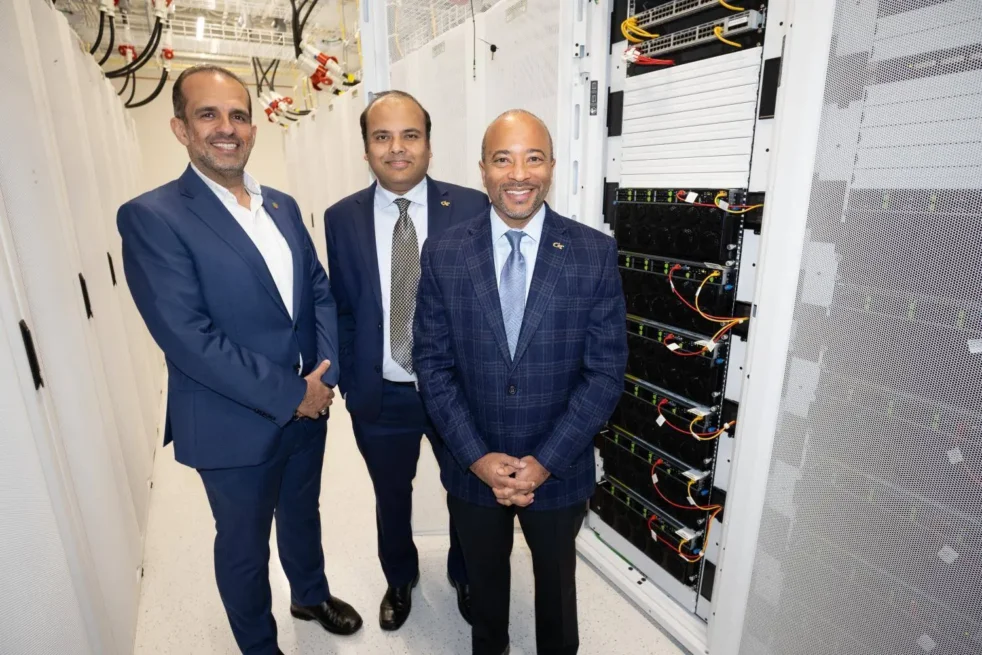Artificial Intelligence (AI) is here to stay. From self-driving cars to chatbots, AI has transitioned from a futuristic concept to a modern reality, entrenching itself in hundreds of industries and revolutionizing how humans live. Recognizing this trend, the College of Engineering (COE) has set up an AI Makerspace in collaboration with NVIDIA to introduce Jackets to this emerging technology and prepare them for an AI-driven future.
This makerspace, located in the CODA Data Center, is a cluster of High Performance
Computers (HPCs) paired with NVIDIA’s AI Enterprise software. Penguin Solutions designed, built and deployed the software infrastructure that serves as a virtual gateway to a high-performance computing environment.
Tech’s Partnership for an Advanced Computing Environment (PACE) provides infrastructure support. It helps with sustainable leading-edge Research Computing and Data (RCD) cyberinfrastructure, software and support for research and education requiring high-performance computing and other advanced research computing infrastructure.
However, what makes this AI makerspace such a heavyweight is the 160 NVIDIA H100 and 144 NVIDIA H200 graphics processing units (GPUs) it houses. For context, if 50,000 students take 22 years to solve a multiplication operation, a single H100 GPU can solve the same problem in a second.
A GPU is a specialized processor that can handle complex computation tasks such as rendering high-resolution graphics, cryptocurrency mining and AI training.
This hub of supercomputers with cutting-edge technology, typically reserved for researchers or industry professionals, democratizes access to AI technology for students. With this makerspace, students can gain hands-on experience, deepen their skills and prepare to become the next generation of AI professionals.
Raheem Beyah, dean of the College of Engineering, echoed this sentiment: “The launch of the AI Makerspace represents another milestone in Georgia Tech’s legacy of innovation and leadership in education,” he said. “Thanks to NVIDIA’s advanced technology and expertise, our students at all levels have a path to make significant contributions and lead in the rapidly evolving field of AI.”
Currently, only classes, VIP teams and Create-X projects have access to this makerspace, with priority access to the COE.
“This is the largest AI Makerspace dedicated completely to students,” said Arijit Raychowdhury, chair of the School of Electrical and Computer Engineering. “I would say that AI is at a place where computing or learning how to program was 20 years ago.”
In Spring 2025 alone, 80 courses across various disciplines were redesigned to integrate the makerspace into their classes, allowing students to leverage its capabilities in their learning and research.
The Institute has already started observing dividends for this exorbitant technology. Since its launch, 1,471 unique users have used 300,000 GPU hours. Booking the same usage from a third-party cloud service would cost at least 750,000 USD.
Aya Samadi, whose capstone project in Spring 2024 utilized the makerspace, expressed how potent the resource is.
“With the resources of the AI Makerspace, we were not only able to successfully train the model, but it was also much faster than if we had to use publicly available methods,” she added.
The makerspace is a welcome addition to COE’s “AI for Engineering” initiative. As per this initiative, the graduates will be “well-versed in artificial intelligence principles and ready to enter an AI-native workforce.”
The Institute has other HPC resources available on campus, which PACE maintains. The Phoenix cluster, Hive Cluster and Firebird cluster are a few examples. However, none of them are as powerful as the AI Makerspace.
NVIDIA, which is at the forefront of GPU manufacturing, has partnered with The Institute to provide the AI hardware and software behind the makerspace. Moreover, it provides deep learning resources, including faculty-led workshops, certifications, curriculum-aided teaching kits and a developer community network to enhance student learning.
“AI supercomputers provide a platform to help drive powerful new discoveries that could solve some of the world’s most complex challenges,” said Cheryl Martin, director of Higher Education and Research at NVIDIA.
“Georgia Tech’s AI Makerspace will provide students with access to NVIDIA’s accelerated computing platform, equipping them with the technology to push the boundaries of AI learning and research.”
The AI Makerspace is not just a milestone for Tech but also a significant addition to Atlanta’s technological ecosystem.
“The City of Atlanta commends the leadership of Georgia Tech and the College of Engineering in advancing education and technology through the AI Makerspace,” said Atlanta Mayor Andre Dickens. “Partnerships with industry leaders such as NVIDIA propel our students and workforce toward tomorrow, further enhancing Atlanta’s status as an innovation hub.”
Matthieu Bloch, Associate Dean for Academic Affairs in the College of Engineering, and his team are working behind the scenes to set up student governance of the makerspace, similar to that of other physical makerspaces across campus. His team is exploring ideas such as adding mentors and instructors, creating modules and certifications for first-time users and forming a committee to approve requests.
Such a structure will also help open the resource to student organizations, third-party-funded research and other non-instruction applications.
Nonetheless, Bloch emphasized that classes will be prioritized. “Our number one priority is always going to be to support instruction first,” he added.
Tech also plans to establish the AI Makerspace Omniverse in 2026, a sandbox for augmented and virtual reality.
Despite being in use around the clock, the makerspace’s computing power is yet to reach its true potential. “300 GPUs is a lot of computing power,” Bloch emphasized. “I want the students to surprise us … My goal is to break it down so that I can go back and ask for more money to expand the makerspace,” he joked.
